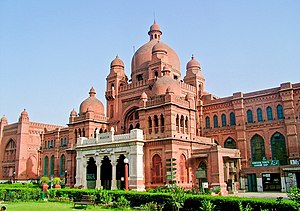Lahore Museum|
 Entrance to the museum |
|
| Established | 1865, later shifted to present site 1894 |
|---|
| Location | The Mall, Lahore
Punjab
Pakistan |
|---|
| Coordinates | 31°34′06″N 74°18′29″E / 31.568226°N 74.308174°E / 31.568226; 74.308174 |
|---|
| Type | Archaeology, art, heritage, modern history, religious |
|---|
| Collection size | Pre & Proto, Coins, Hindu Buddhist & Jain, Gandhara, Islamic, Manuscripts, Miniature Paintings, General Collection, Arms, Ethnological, Postage & Stamps, Arts & Crafts, Contemporary Paintings, Pakistan Movement Gallery |
|---|
| Visitors | 250,000 in 2005 |
|---|
| Website | Official website |
|---|
The Lahore Museum or Ajaib Ghar (Urdu: Wonder House) is a museum in the city of Lahore, Pakistan. It is the largest and best museum in the country.
History
The original old Lahore Museum was made during British Indian times in the 1860s, in what had been the old 'Punjab Exhibition Hall'[1] and the famous gun Zam Zama was installed outside it in 1870. This old museum, along with the Punjab School of Arts (later the Mayo College of Arts) was looked after by John Lockwood Kipling (1837-1911) father of the writer Rudyard Kipling, who mentioned the museum and Zam Zama in his Kim (book) (1901).[2] In 1894, the museum's new building was completed and it moved there[3] the same year, right opposite the old campus of the University of the Punjab, on the Mall.
Collection
The Lahore Museum is set in its beautiful grounds and has one of the best collections of arts and artifacts in its galleries in South Asia. Especially notable are:
References
- ↑ Handbook of the Punjab,Lahore, 1864
- ↑ Peter Hopkirk, Quest for Kim, London:J Murray, 1996, pp.42-45
- ↑ the old building then became the Tollinton Market, Lahore
Further reading
Other websites